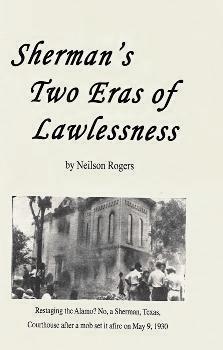
William
Clark Quantrill was known as vicious guerrilla who enlisted in a
Confederate military unit in Oklahoma for six months, serving two tours
of duty. Quantrill's Guerrillas claimed to support the Confederate
cause while ignoring the rules of warfare.
Quantrill's Guerrillas
wintered at their headquarters in Grayson County, Texas called Camp
Lookout which was located near Gordonville. Their reputation was known
and felt far and wide which was enough to restrain criminal activity
for fear of retribution. Citizens of Sherman, Texas respected
and/or feared them. There were very few violators of the law because
those who might contemplate crime feared punishment by the guerrillas.

pg. 15
Source

Tyler Morning Telegraph
Sunday, December 15. 2013
Written by EMILY GUEVARACivil War guerrilla earns reputation for brutality Almost
150 years ago, a triple hanging took place in a small grove of trees
off West Erwin Street near its intersection with Confederate Avenue. Although
largely forgotten, the incident shed light on the violence going on at
the time and how the Civil War played out on the local landscape. It
was the 1860s and “Texas began to shape its image as a haven for
outlaws, gunmen and desperadoes,” according to the book, “A Civil War
Tragedy: Quantrill’s Guerrillas and the 1864 Triple Hanging in Tyler,
Texas.” William Clarke
Quantrill was a Civil War guerrilla leader who came to Texas in 1863 in
part to winter here, but also to escape payback for several of his
previous attacks, according to The Handbook of Texas online. The
man had earned quite a reputation for brutality. In August 1863, he and
his posse looted Lawrence, Kan., shooting about 180 men and boys in the
process, according to the online handbook. While
on their way to Texas, they attacked and killed 80 men and wounded 18
in the Baxter Springs (Kansas) Massacre. He and his men murdered many
people after they surrendered, according to the handbook. Still,
the man managed to make friends when he came to this state, partly
because he provided defense and protection for some communities. He and
his men possibly acted as police against cattle thieves. In
addition, “with Confederate deserters, as well as conscription dodgers,
hiding in the thickets of northern East Texas and often preying on
people, Quantrill’s arrival was welcomed in some communities
because they hoped his presence would bring peace to the region,”
according to “A Civil War Tragedy.” He
is credited with preventing violence on some occasions, such as when he
and his men ended a “near-riot of county ‘war widows’ who were
convinced the Confederate commissary in Sherman was withholding” the
good stuff from them, such as coffee, tea and sugar, according to the
online handbook.
But where the story of Quantrill ties with Tyler starts with the murder of John Lackey.
Lackey
was at home one day in 1863 when brothers from the Calhoun family,
believed to be associates of Quantrill, came to his house in Millwood
in Collin County and demanded his money. When
he said he had none, they tortured him. And when Lackey still denied
having money, they ransacked his house, killed him in front of his wife
and abused her, according to “A Civil War Tragedy.” One
of Lackey’s neighbors, James McReynolds, a former Collin County chief
justice, convinced the county sheriff that the Calhoun brothers
committed the crime.
Sheriff
James Read investigated it, found it to be true and learned that the
brothers planned to kill “old man McReynolds” next. So, instead of
waiting for the killing to happen, Read acted first. On
December 29, 1863, he and a group of trusted men followed the Calhoun
brothers and killed two of them. A third one escaped and a fourth
apparently wasn’t involved, according to “A Civil War Tragedy.” More
than a month later, Read was arrested on murder charges. However, at
the trial he was found not guilty of killing David and James Calhoun. That
didn’t stop associates of the Calhouns from fighting back. A group of
raiders came into McKinney and engaged in a half-day gun battle with
Read, McReynolds and their allies, according to “A Civil War Tragedy.” It
was during this fight that Read and McReynolds escaped, and with Read’s
family, fled to Four Mile Prairie, a settlement west of Canton,
according to the book. While
there, they were seized by “enrollers,” Van Zandt County and Henderson
County men who tracked down Confederate deserters, absentees from the
war and “jayhawkers,” also described as “freebooting guerrillas,”
according to the book. The enrollers also took Joseph E. Holcomb, Read’s brother-in-law. After
being brought before several Confederate and county officials, the men
were brought to enrolling official James M. Taylor in Tyler. Taylor
told them to take the men to Camp Ford for the night and come back in
the morning so he could inspect their papers. The
next day, Taylor found that the men weren’t “subject to military arrest
in the first place” nor to conscription as soldiers in the Confederate
Army, according to “A Civil War Tragedy.” He said if they were guilty of any civil offense, they should be handed over to civil authorities, according to the book. A crowd reportedly stormed the enrollment office building that afternoon, demanding the men. When they got them, they tied them up, carried them downstairs and left the Tyler square headed west toward Canton. They had four men — Read, McReynolds, Holcomb and Jeff Davis, who also had been arrested. The mob stopped less than a mile down the road near the intersection of West Erwin Street and Confederate Avenue. There, they conducted a mock trial where they asked the men to plead guilty or not guilty. They
then hung Read, McReynolds and Holcomb, but let Davis go after a man in
the crowd vouched for his Army service and said he wasn’t associated
with the other three.
Felony
Susan Hawkins
© 2024
If
you find any of Grayson
CountyTXGenWeb links inoperable, please
send me a message.
|


